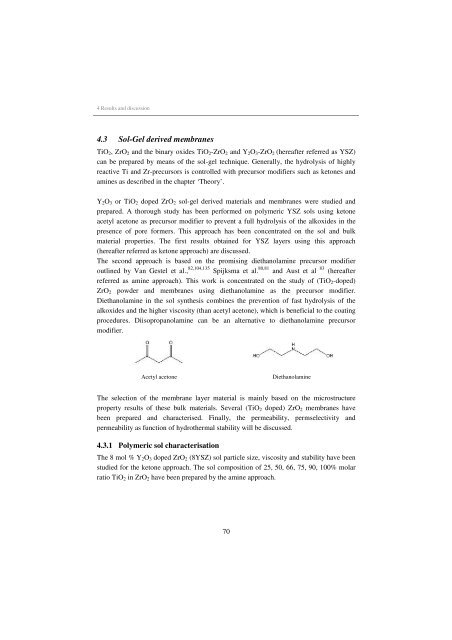Inorganic Microporous Membranes for Gas Separation in Fossil Fuel ...
Inorganic Microporous Membranes for Gas Separation in Fossil Fuel ...
Inorganic Microporous Membranes for Gas Separation in Fossil Fuel ...
Create successful ePaper yourself
Turn your PDF publications into a flip-book with our unique Google optimized e-Paper software.
4 Results and discussion<br />
4.3 Sol-Gel derived membranes<br />
TiO2, ZrO2 and the b<strong>in</strong>ary oxides TiO2-ZrO2 and Y2O3-ZrO2 (hereafter referred as YSZ)<br />
can be prepared by means of the sol-gel technique. Generally, the hydrolysis of highly<br />
reactive Ti and Zr-precursors is controlled with precursor modifiers such as ketones and<br />
am<strong>in</strong>es as described <strong>in</strong> the chapter ‘Theory’.<br />
Y2O3 or TiO2 doped ZrO2 sol-gel derived materials and membranes were studied and<br />
prepared. A thorough study has been per<strong>for</strong>med on polymeric YSZ sols us<strong>in</strong>g ketone<br />
acetyl acetone as precursor modifier to prevent a full hydrolysis of the alkoxides <strong>in</strong> the<br />
presence of pore <strong>for</strong>mers. This approach has been concentrated on the sol and bulk<br />
material properties. The first results obta<strong>in</strong>ed <strong>for</strong> YSZ layers us<strong>in</strong>g this approach<br />
(hereafter referred as ketone approach) are discussed.<br />
The second approach is based on the promis<strong>in</strong>g diethanolam<strong>in</strong>e precursor modifier<br />
outl<strong>in</strong>ed by Van Gestel et al., 82,104,135 Spijksma et al. 80,81 and Aust et al 83 (hereafter<br />
referred as am<strong>in</strong>e approach). This work is concentrated on the study of (TiO2-doped)<br />
ZrO2 powder and membranes us<strong>in</strong>g diethanolam<strong>in</strong>e as the precursor modifier.<br />
Diethanolam<strong>in</strong>e <strong>in</strong> the sol synthesis comb<strong>in</strong>es the prevention of fast hydrolysis of the<br />
alkoxides and the higher viscosity (than acetyl acetone), which is beneficial to the coat<strong>in</strong>g<br />
procedures. Diisopropanolam<strong>in</strong>e can be an alternative to diethanolam<strong>in</strong>e precursor<br />
modifier.<br />
Acetyl acetone Diethanolam<strong>in</strong>e<br />
The selection of the membrane layer material is ma<strong>in</strong>ly based on the microstructure<br />
property results of these bulk materials. Several (TiO2 doped) ZrO2 membranes have<br />
been prepared and characterised. F<strong>in</strong>ally, the permeability, permselectivity and<br />
permeability as function of hydrothermal stability will be discussed.<br />
4.3.1 Polymeric sol characterisation<br />
The 8 mol % Y2O3 doped ZrO2 (8YSZ) sol particle size, viscosity and stability have been<br />
studied <strong>for</strong> the ketone approach. The sol composition of 25, 50, 66, 75, 90, 100% molar<br />
ratio TiO2 <strong>in</strong> ZrO2 have been prepared by the am<strong>in</strong>e approach.<br />
70

















